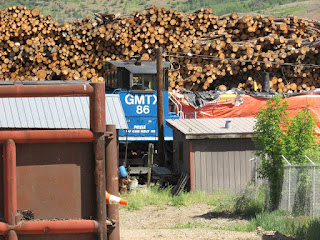Some people like mainline running. Others like industrial switching. For
Mike Lisowski, it’s prairie branchlines that captured his interest.
In particular, Mike is modelling CN operations in summer, 1980 in the
Manitoba town of Neepawa, located about two hours northwest of Winnipeg.
Mike’s N scale layout, which he started in 2016, is a loop-type diorama-style
model railroad that measures 2 feet wide by 17 feet long.
The layout is centred on the rural agricultural town of Neepawa, with
its yard, grain elevators and trestle south of town.
The layout doesn’t have staging, but a train can disappear into a hidden
trench behind the scenery, reappearing as coming from the opposite direction.
Mike uses DCC to operate the layout. For now, he says, he
just runs trains, but is in the process of making up several hundred cards to cover
simulated typewritten orders governing trains and switch lists.
Scenery is made from extruded polystyrene foam, topped by ground
foam, real sand and gravel and actual concrete for roads.
Trees are a mix of commercial kits for foreground trees and
Woodland Scenics clump foliage for background trees.
Ninety percent of the buildings are
scratchbuilt, including both elevators and their annexes/sheds, the big coal
dealer’s shed, Sherritt Fertilizers, and the biggest feature on the layout, the
scratchbuilt trestle.
The trestle, which lasted until 1981 on the prototype, contains
528 individually cut pieces of strip styrene. It is finished with a five-step
painting process to look like wood (a mix of treated and untreated timbers).
Right now, the layout is supported by a standard wood frame.
Mike’s plan is for it to eventually be supported by built-in cabinetry.
For track, Mike uses a mix of Atlas and Micorengineering code 55 flextrack and
Microengineering code 55 #6 turnouts. Seventy-five percent of the track is
laid.
Locomotives and power are appropriate for the time and place
Mike is modelling. As a result, there are few Canadian government cylindrical grain
hoppers since they could not run beyond Neepawa in 1980 (due to light rail
restrictions).
On the layout, Mike uses GMD-1 locomotives from Rapido. The
rolling stock is mostly Intermountain 40-foot grain boxcars, and a few covered
hoppers, along with Microtrains and Roundhouse boxcars and Microtrains
bulkhead flats.
The Pointe St. Charlies cabooses are from Prairie Shadows.
Mike did two years of research and planning before
beginning construction. This included amassing aerial photos taken during the
modelled timeline, research of photos of the rail yard and talking with retired
train crews.
This is not the first
N scale layout Mike has built. He used to have a large 21 by 26 foot layout
that started out as the Union Pacific between Cheyenne and Laramie WY before he
converted it to the Saskatchewan prairies (the CN Central Butte Sub. west of
Moose Jaw).
This included
scratchbuilding a GMD-1 in N scale, 20 years before Rapido made one
commercially. It required parts from five units, so Mike is happy Rapido came
along!
When he moved, the
layout—which was almost complete—was dismantled and most of the equipment sold
off.
Although that layout
was gone, the seeds were sown for modelling the prairies, and the present Great
Canadian Model Railroad is the result.























